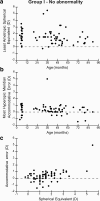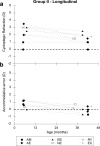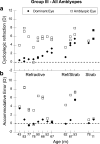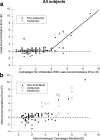The accommodative lag of the young hyperopic patient
- PMID: 22125280
- PMCID: PMC3292355
- DOI: 10.1167/iovs.11-8174
The accommodative lag of the young hyperopic patient
Abstract
Purpose: To determine the accommodative accuracy of infants and young children before they had had any form of clinical intervention or treatment, in an attempt to determine the difference between 'normal' and 'abnormal' visual experience for these individuals.
Methods: Nott retinoscopy was performed on 111 subjects in binocular viewing conditions at a viewing distance of 50 cm. The target was a naturalistic cartoon image with a broadband spatial frequency amplitude spectrum.
Results: Accommodative accuracy was not related to age (4-90 months). In the group found to have no apparent clinical abnormality (n = 71), the mean lag in the more hyperopic meridian of the least ametropic eye was 0.34 diopters (D). When considering the group as a whole, those with less than approximately 4 D of hyperopia demonstrated similar lags, while those with higher hyperopia, amblyopia, or strabismus had more variable lags. An ROC analysis designed to detect hyperopia >5 D in any meridian, amblyopia and/or strabismus had an area under the curve of 0.90 (95% confidence interval [CI], 0.82 to 0.95), and for a lag criterion of 1.3 D had a sensitivity of 83.3% and a specificity of 96.5%.
Conclusions: These data from a relatively small but broad sampling of age and clinical status suggest that clinically normal young infants and children with low amounts of hyperopia have similar lags of accommodation from the first few months after birth. Subjects with greater than 4 D of hyperopia, or amblyopia or strabismus, have more variable lags and therefore evidence of abnormal visual experience.
Figures





Similar articles
-
Why do only some hyperopes become strabismic?Invest Ophthalmol Vis Sci. 2013 Jul 24;54(7):4941-55. doi: 10.1167/iovs.12-10670. Invest Ophthalmol Vis Sci. 2013. PMID: 23883788 Free PMC article. Review.
-
The Role of Dynamic Retinoscopy in Predicting Infantile Accommodative Esotropia and Influencing Emmetropization.J Binocul Vis Ocul Motil. 2018 Apr-Jun;68(2):54-58. doi: 10.1080/2576117X.2018.1468685. J Binocul Vis Ocul Motil. 2018. PMID: 30196757
-
Visual Function of Moderately Hyperopic 4- and 5-Year-Old Children in the Vision in Preschoolers - Hyperopia in Preschoolers Study.Am J Ophthalmol. 2016 Oct;170:143-152. doi: 10.1016/j.ajo.2016.07.017. Epub 2016 Jul 29. Am J Ophthalmol. 2016. PMID: 27477769 Free PMC article.
-
Emmetropization, visual acuity, and strabismus outcomes among hyperopic infants followed with partial hyperopic corrections given in accordance with dynamic retinoscopy.Eye (Lond). 2014 Oct;28(10):1165-73. doi: 10.1038/eye.2014.161. Epub 2014 Jul 18. Eye (Lond). 2014. PMID: 25033902 Free PMC article.
-
The Importance of the Interaction Between Ocular Motor Function and Vision During Human Infancy.Annu Rev Vis Sci. 2019 Sep 15;5:201-221. doi: 10.1146/annurev-vision-091718-014741. Annu Rev Vis Sci. 2019. PMID: 31525140 Free PMC article. Review.
Cited by
-
Blur Detection, Depth of Field, and Accommodation in Emmetropic and Hyperopic Children.Optom Vis Sci. 2018 Mar;95(3):212-222. doi: 10.1097/OPX.0000000000001177. Optom Vis Sci. 2018. PMID: 29401180 Free PMC article.
-
Accuracy of WASCA Aberrometer Refraction Compared to Manifest Refraction and Cycloplegic Refraction in Hyperopia Measurement.Transl Vis Sci Technol. 2020 Oct 6;9(11):5. doi: 10.1167/tvst.9.11.5. eCollection 2020 Oct. Transl Vis Sci Technol. 2020. PMID: 33101782 Free PMC article.
-
Why do only some hyperopes become strabismic?Invest Ophthalmol Vis Sci. 2013 Jul 24;54(7):4941-55. doi: 10.1167/iovs.12-10670. Invest Ophthalmol Vis Sci. 2013. PMID: 23883788 Free PMC article. Review.
-
Subjective versus objective accommodative amplitude: preschool to presbyopia.Optom Vis Sci. 2014 Nov;91(11):1290-301. doi: 10.1097/OPX.0000000000000402. Optom Vis Sci. 2014. PMID: 25602235 Free PMC article.
-
Correction of Low-Moderate Hyperopia Improves Accommodative Function for Some Hyperopic Children During Sustained Near Work.Invest Ophthalmol Vis Sci. 2021 Apr 1;62(4):6. doi: 10.1167/iovs.62.4.6. Invest Ophthalmol Vis Sci. 2021. PMID: 33821881 Free PMC article.
References
-
- Mitchell DE, Timney B. Postnatal development of function in the mammalian visual system. In: Kandel ER, ed. Handbook of Physiology. The Nervous System III. Vol. 3 Washington DC: American Physiological Society; 1984:507–555
-
- Troilo D. Neonatal eye growth and emmetropisation–a literature review. Eye. 1992;6:154–160 - PubMed
-
- Smith EI. Environmentally induced refractive errors in animals. In: Rosenfield M, Gilmartin B, eds. Myopia and Nearwork. Oxford: Butterworth-Heinemann; 1998:57–90
Publication types
MeSH terms
Grants and funding
LinkOut - more resources
Full Text Sources
Medical

